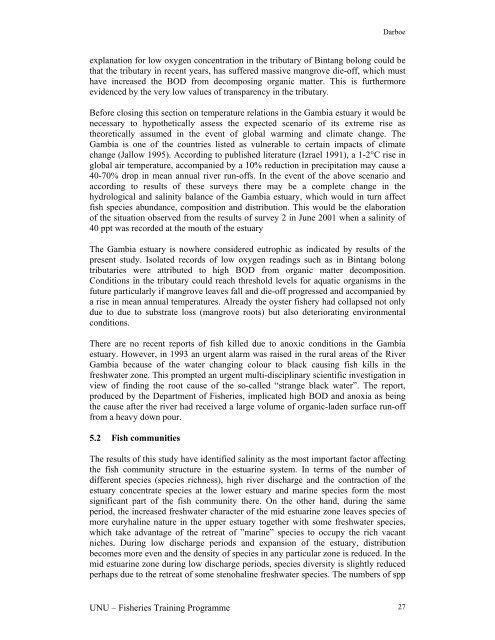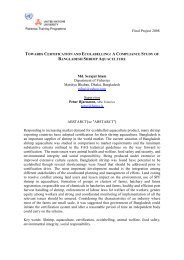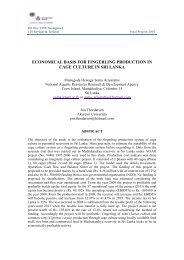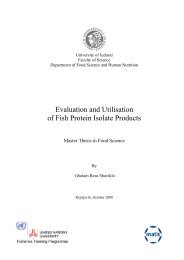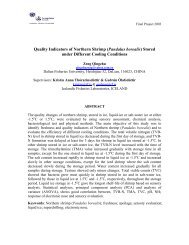Fish species abundance and distribution in The Gambia estuary
Fish species abundance and distribution in The Gambia estuary
Fish species abundance and distribution in The Gambia estuary
Create successful ePaper yourself
Turn your PDF publications into a flip-book with our unique Google optimized e-Paper software.
Darboeexplanation for low oxygen concentration <strong>in</strong> the tributary of B<strong>in</strong>tang bolong could bethat the tributary <strong>in</strong> recent years, has suffered massive mangrove die-off, which musthave <strong>in</strong>creased the BOD from decompos<strong>in</strong>g organic matter. This is furthermoreevidenced by the very low values of transparency <strong>in</strong> the tributary.Before clos<strong>in</strong>g this section on temperature relations <strong>in</strong> the <strong>Gambia</strong> <strong>estuary</strong> it would benecessary to hypothetically assess the expected scenario of its extreme rise astheoretically assumed <strong>in</strong> the event of global warm<strong>in</strong>g <strong>and</strong> climate change. <strong>The</strong><strong>Gambia</strong> is one of the countries listed as vulnerable to certa<strong>in</strong> impacts of climatechange (Jallow 1995). Accord<strong>in</strong>g to published literature (Izrael 1991), a 1-2°C rise <strong>in</strong>global air temperature, accompanied by a 10% reduction <strong>in</strong> precipitation may cause a40-70% drop <strong>in</strong> mean annual river run-offs. In the event of the above scenario <strong>and</strong>accord<strong>in</strong>g to results of these surveys there may be a complete change <strong>in</strong> thehydrological <strong>and</strong> sal<strong>in</strong>ity balance of the <strong>Gambia</strong> <strong>estuary</strong>, which would <strong>in</strong> turn affectfish <strong>species</strong> <strong>abundance</strong>, composition <strong>and</strong> <strong>distribution</strong>. This would be the elaborationof the situation observed from the results of survey 2 <strong>in</strong> June 2001 when a sal<strong>in</strong>ity of40 ppt was recorded at the mouth of the <strong>estuary</strong><strong>The</strong> <strong>Gambia</strong> <strong>estuary</strong> is nowhere considered eutrophic as <strong>in</strong>dicated by results of thepresent study. Isolated records of low oxygen read<strong>in</strong>gs such as <strong>in</strong> B<strong>in</strong>tang bolongtributaries were attributed to high BOD from organic matter decomposition.Conditions <strong>in</strong> the tributary could reach threshold levels for aquatic organisms <strong>in</strong> thefuture particularly if mangrove leaves fall <strong>and</strong> die-off progressed <strong>and</strong> accompanied bya rise <strong>in</strong> mean annual temperatures. Already the oyster fishery had collapsed not onlydue to due to substrate loss (mangrove roots) but also deteriorat<strong>in</strong>g environmentalconditions.<strong>The</strong>re are no recent reports of fish killed due to anoxic conditions <strong>in</strong> the <strong>Gambia</strong><strong>estuary</strong>. However, <strong>in</strong> 1993 an urgent alarm was raised <strong>in</strong> the rural areas of the River<strong>Gambia</strong> because of the water chang<strong>in</strong>g colour to black caus<strong>in</strong>g fish kills <strong>in</strong> thefreshwater zone. This prompted an urgent multi-discipl<strong>in</strong>ary scientific <strong>in</strong>vestigation <strong>in</strong>view of f<strong>in</strong>d<strong>in</strong>g the root cause of the so-called “strange black water”. <strong>The</strong> report,produced by the Department of <strong>Fish</strong>eries, implicated high BOD <strong>and</strong> anoxia as be<strong>in</strong>gthe cause after the river had received a large volume of organic-laden surface run-offfrom a heavy down pour.5.2 <strong>Fish</strong> communities<strong>The</strong> results of this study have identified sal<strong>in</strong>ity as the most important factor affect<strong>in</strong>gthe fish community structure <strong>in</strong> the estuar<strong>in</strong>e system. In terms of the number ofdifferent <strong>species</strong> (<strong>species</strong> richness), high river discharge <strong>and</strong> the contraction of the<strong>estuary</strong> concentrate <strong>species</strong> at the lower <strong>estuary</strong> <strong>and</strong> mar<strong>in</strong>e <strong>species</strong> form the mostsignificant part of the fish community there. On the other h<strong>and</strong>, dur<strong>in</strong>g the sameperiod, the <strong>in</strong>creased freshwater character of the mid estuar<strong>in</strong>e zone leaves <strong>species</strong> ofmore euryhal<strong>in</strong>e nature <strong>in</strong> the upper <strong>estuary</strong> together with some freshwater <strong>species</strong>,which take advantage of the retreat of ”mar<strong>in</strong>e” <strong>species</strong> to occupy the rich vacantniches. Dur<strong>in</strong>g low discharge periods <strong>and</strong> expansion of the <strong>estuary</strong>, <strong>distribution</strong>becomes more even <strong>and</strong> the density of <strong>species</strong> <strong>in</strong> any particular zone is reduced. In themid estuar<strong>in</strong>e zone dur<strong>in</strong>g low discharge periods, <strong>species</strong> diversity is slightly reducedperhaps due to the retreat of some stenohal<strong>in</strong>e freshwater <strong>species</strong>. <strong>The</strong> numbers of sppUNU – <strong>Fish</strong>eries Tra<strong>in</strong><strong>in</strong>g Programme 27


